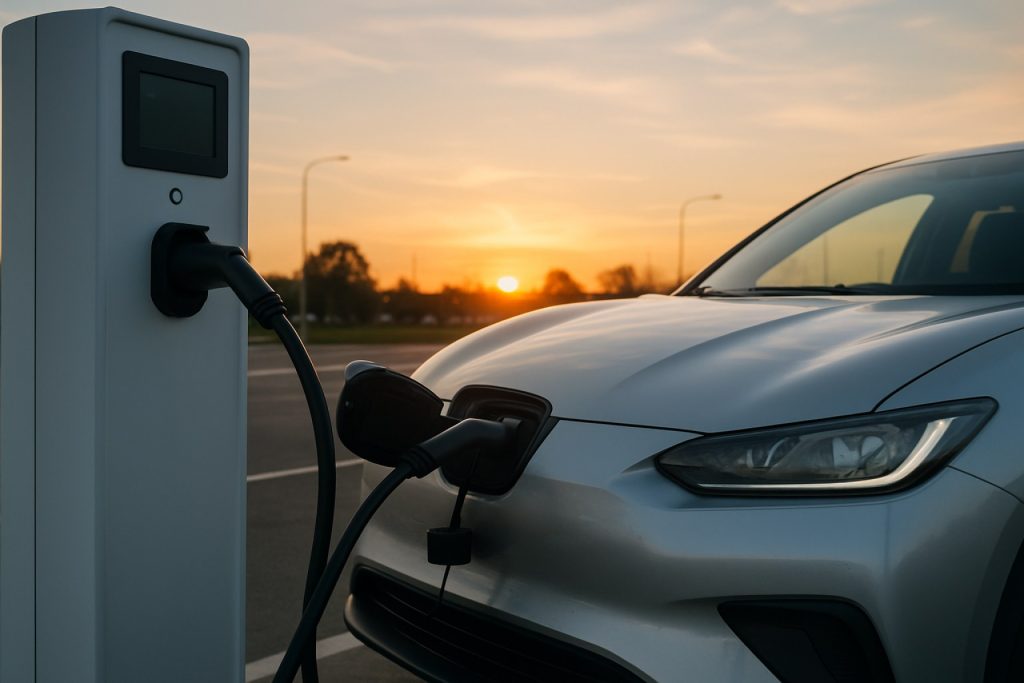
- Electric vehicles (EVs) are rapidly replacing traditional gasoline cars, with one in four vehicles sold globally expected to be electric by 2025.
- Over 20 million EVs will be sold worldwide in 2025, and EV market share could exceed 40% by 2030.
- China leads EV adoption, but strong growth is seen across Asia and Latin America; the US and Europe follow with steady increases.
- Lower lifetime costs and significant reductions in emissions drive EV popularity, improving air quality and reducing reliance on fossil fuels.
- Challenges with battery materials and infrastructure remain, but investment and innovation are helping to overcome them.
- The global transition to EVs signals cleaner, cheaper, and more sustainable transportation for billions.
Electric vehicles surge forward, steadily outpacing the combustion engine’s century-long reign. Beneath the hum of global headlines, a seismic shift is unfolding on dealership floors and city streets: by next year, every fourth car sold worldwide will be powered by electricity, reshaping what mobility means for billions.
Stand back, and the scale of change is staggering. In 2025 alone, over 20 million EVs are projected to hit the world’s roads—a volume echoing through supply chains and refineries alike. The numbers whisper of transformation: global EV sales rocketed 35% in early 2025, foreshadowing a world where electric cars could surpass 40% market share by 2030.
China moves like a colossus among EV adopters. Nearly half the new cars rolling out onto Chinese highways now glide in silence, battery instead of tailpipe. Rapid adoption isn’t confined to Chinese megacities. Across sprawling Asian nations and vibrant Latin American metropolises, EV sales are climbing by more than 60%. America and Europe, more measured, still advance—posting 10% and 20% gains this year, their streets growing a little quieter, a little cleaner, with each purchase.
Why the stampede toward electric? Money talks, and so do lungs. Lower lifetime costs—thanks to reduced gas and maintenance needs—make EVs wallet-friendly over the long haul. At the same time, every electric mile curbs the haze of exhaust and slices into tailpipe emissions, yielding streets with crisper air and fewer heat-trapping gases. According to leading climate and energy experts, the typical EV slashes pollution per mile in half compared to conventional cars. These benefits extend beyond the curb: every barrel of oil left in the ground loosens the influence of fossil fuels on global policy and local economies.
The International Energy Agency is set to dive deeper this summer, unveiling insights into just how fiercely EVs are competing—and how automakers are scrambling to rewire their supply chains for a cleaner era. Concerns swirl about battery materials and infrastructure, yet the pace of innovation suggests bottlenecks are yielding to investment and ingenuity.
The takeaway is clear: the future of driving hums with electricity, not gasoline. As EVs become cheaper and more accessible, they are opening doors to a world that is less polluted, less dependent on oil, and ultimately more resilient. The journey is far from over, but with each new electric vehicle rolling off production lines, the road ahead looks a little brighter—and a lot more electric.
For deeper dives into cutting-edge energy news and environmental innovation, the IEA is a rich resource worth bookmarking.
The Electric Revolution: 20 Million EVs Will Hit Roads in 2025—Everything Drivers Need to Know (and Nobody’s Telling You!)
A Deep Dive into the Global Electric Vehicle (EV) Boom: Unseen Facts, Industry Trends, Hacks, and Predictions
The Pandemic of Progress: Key Facts Not Fully Explored
1. Government Incentives Drive Adoption:
Many countries offer immediate financial benefits for EV buyers, from tax rebates to purchase grants. For example, Germany offers up to €9,000 in incentives, while the U.S. reintroduced a $7,500 federal tax credit for qualifying vehicles. These policies have proven decisive in accelerating consumer adoption ([IEA](https://www.iea.org), U.S. DOE, German Federal Government).
2. Battery Tech Leapfrogs with LFP and Solid-State:
Lithium iron phosphate (LFP) batteries are now standard in many new models, especially from leading manufacturers like BYD and Tesla. LFP batteries are cheaper and more durable, though slightly less energy-dense than nickel-based counterparts. Solid-state batteries—offering 2x energy density, faster charging, and improved safety—are expected to enter mass production by 2027 (source: BloombergNEF).
3. Charging Networks Expand at Lightning Speed:
Globally, public EV charging points surpassed 4 million by the end of 2024. China operates over 65% of the world’s fast chargers, while Europe’s ultra-fast networks (Ionity, Fastned) have expanded across key highway corridors. Home charging is overwhelmingly popular—over 80% of EV owners in North America and Europe prefer it.
4. Major Automakers Pivot to Electric:
VW aims for 80% of new car sales in Europe to be electric by 2030. GM intends to stop selling combustion cars by 2035. Even holdouts like Toyota and Mazda have dramatically ramped up EV investment after years of hybrid focus.
Real-World Use Cases & Life Hacks
– Commuter Cost Savings:
Driving an EV in the U.S. can cut annual “fuel” costs by over 70% versus gasoline (U.S. Department of Energy). Maintenance savings alone range from $400–$1,500 per year.
– Home Charging Hack:
Install a smart Level 2 charger at home. Use “time of use” (TOU) utility rates to schedule charging for low-demand, lower-cost overnight hours—save 20–40% more.
– Road Trips:
Plan routes with apps like PlugShare or A Better Route Planner for stress-free long-distance journeys—functionality includes charger location, charger type, and real-time availability.
Market Forecasts & Industry Trends
– Global Share:
IEA forecasts EV market share to surpass 40% by 2030; in leading markets like China, Norway, and the Netherlands, it’s likely to hit 80%+.
– Vehicle Types:
Electrification is moving into trucks, delivery vans, buses, and even heavy construction equipment (Volvo, Daimler, CAT). In California, electric buses outnumber diesel models in some urban areas.
– Used EV Market Booming:
With many early-lease EVs returning to dealers, the used EV market is up 50% year-on-year in Europe, lowering the financial barrier for new adopters.
Reviews, Comparisons & Pressing Questions
Q1: How do today’s EVs compare in range, performance, and price?
– Range:
Modern mainstream EVs (e.g., Tesla Model 3, Hyundai Ioniq 6, Polestar 2) offer 200–400+ miles per charge.
– Performance:
Instant torque means brisk acceleration—many models sprint from 0 to 60 mph in under 6 seconds.
– Price:
Entry-level EVs start around $25,000–$35,000 after incentives (e.g., Chevrolet Bolt, BYD Dolphin). Premium models exceed $60,000.
Q2: How sustainable is EV battery production?
– Major battery makers (CATL, LG, Panasonic) are investing in ethical sourcing, recycling, and green manufacturing. Startups (e.g., Redwood Materials, Northvolt) aim for ‘closed-loop’ battery recycling, reducing mining impacts and boosting sustainability.
Security & Sustainability
– Cybersecurity:
Connected EVs are ‘rolling data centers.’ Automakers are investing in software security, while national agencies (e.g., NHTSA, ENISA) provide cybersecurity guidelines to protect vehicles from hacking.
– Emissions:
According to the IEA, even in regions with fossil-fuel-heavy grids, EVs emit 20–40% less CO2 across their lifecycle vs. new gasoline vehicles.
Pros & Cons Overview
Pros:
– Lower operating and fuel costs
– Smoother, instant torque driving experience
– Quieter ride; zero tailpipe emissions
– Eligible for government incentives and perks
Cons:
– Upfront price may be higher (but falling fast)
– Charging infrastructure still catching up, rural gaps remain
– Battery degradation over 8–15 years (but warranty coverage standard)
Controversies & Limitations
– Critical Materials (Cobalt, Nickel, Lithium):
Human rights and environmental concerns remain, especially in mining regions. Industry and regulatory focus on ethical sourcing, traceability.
– Grid Impact:
In high-adoption markets, grid upgrades and smart-charging systems are needed to manage peak loads (source: Rocky Mountain Institute).
– End-of-life Recycling:
Less than 10% of EV batteries are currently recycled, but that number is projected to surpass 60% by 2030 as dedicated facilities launch (Benchmark Minerals).
Insight & Predictions
– By 2030: Expect robust, global charging networks, at least one major city banning non-electric new car sales, and falling EV prices rivaling gas models everywhere.
– Second-life batteries (repurposed for grid energy storage) will become common, accelerating renewable energy use.
Quick-Start How-To: First-Time EV Owner
1. Research Incentives:
National and local government incentives can slash sticker price—check eligibility before buying.
2. Select the Right Charger:
If possible, install a home Level 2 (240V) charger for fastest, most cost-effective daily charging.
3. Download Apps:
Get familiar with charging apps to locate stations on the go.
4. Plan Maintenance:
Look for automaker programs focused on EV health checks; anticipate lower servicing needs overall.
5. Track Electricity Rates:
Ask your utility about EV-friendly or ‘time of use’ tariffs.
Actionable Takeaways
– Bookmark the International Energy Agency portal for the latest energy and EV trends.
– Consider your personal driving patterns: if you drive less than 40 miles/day, almost any EV will fit your routine.
– If concerned about resale value, lease an EV until the used market stabilizes further.
– For apartment dwellers, advocate with property managers for charging station installation—community EV demand is your ally.
The road ahead is electric—embrace the change for a cleaner, cheaper, and more resilient mobility future!



